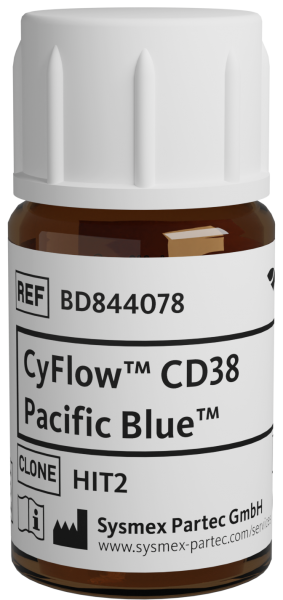CyFlow™ CD38 Pacific Blue™

| Alternative Name: | T10 |
| Antigen: | CD38 |
| Application: | Flow cytometry |
| Clonality: | monoclonal |
| Clone: | HIT2 |
| Emission Maximum: | 455 nm |
| Excitation Maximum: | 400 to 410 nm |
| Field of Interest: | Immunophenotyping |
| Format/Fluorochrome: | Pacific Blue™ |
| Isotype: | IgG1 |
| Laser: | Violet |
| Regulatory Status: | CE IVD |
| Source Species: | Mouse |
| Target Species: | Human |
| Product number: | BD844078 |
CE IVD
| HLDA Workshop | HLDA III—WS Code T 155 |
| Concentration Unit | µg/mL |
| Concentration | 50 |
| Quantity | 100 tests |
| Volume | 1.0 mL |
| Immunogen | Human thymocytes in foetus |
| Background Information | CD38 (NAD+ glycohydrolase) is a type II transmembrane glycoprotein able to induce activation, proliferation and differentiation of mature lymphocytes and mediate apoptosis of myeloid and lymphoid progenitor cells. Another role of CD38 is provided by enzymatic activity of its extracellular part. CD38 acts as NAD+ glycohydrolase converting NAD+ into ADP-ribose, as ADP-ribosyl cyclase producing cADPR and as cADPR hydrolase, thus affecting levels of calcium-mobilizing metabolites. ADPR produced by CD38 serves as an important second messenger of neutrophil and dendritic cell migration. |
| Antigen Distribution | CD38 (T10) is a 45 kDa type II transmembrane glycoprotein strongly expressed mainly on plasma cells and activated T and B lymphocytes; it is an antigenic marker of lymphoid cells. CD38 is able to induce activation, proliferation and differentiation of mature lymphocytes and mediate apoptosis of myeloid and lymphoid progenitor cells. Another role of CD38 is provided by enzymatic activity of its extracellular part. |
| Usage | CE IVD usage Placeholder |
| Storage Buffer | The reagent is provided in stabilizing phosphate buffered saline (PBS) solution, pH ≈7.4, containing 0.09% (w/v) sodium azide and 0.2% (w/v) BSA. |
| Storage | Avoid prolonged exposure to light. Store in the dark at 2-8°C. Do not freeze. |
| Stability | Do not use after expiration date stamped on vial label. |
| McMichael AJ, Beverley PCL, Cobbold S, et al (Eds): Leucocyte Typing III, White Cell Differentiation Antigens. Oxford University Press, Oxford. 1987; 1‑1050. < NLM ID: 8913266 > | Cakir-Kiefer C, Muller-Steffner H, Oppenheimer N, Schuber F: Kinetic competence of the cADP‑ribose‑CD38 complex as an intermediate in the CD38/NAD+ glycohydrolase‑catalysed reactions: implication for CD38 signalling. Biochem J. 2001 Sep 1; 358(2):399‑406. < PMID: 11513738 > | Lund FE, Muller-Steffner H, Romero-Ramirez H, Moreno-García ME, Partida-Sánchez S, Makris M, Oppenheimer NJ, Santos-Argumedo L, Schuber F: CD38 induces apoptosis of a murine pro‑B leukemic cell line by a tyrosine kinase‑dependent but ADP‑ribosyl cyclase‑ and NAD glycohydrolase‑independent mechanism. Int Immunol. 2006 Jul; 18(7):1029‑42. < PMID: 16720618 > | Kolar GR, Mehta D, Pelayo R, Capra JD: A novel human B cell subpopulation representing the initial germinal center population to express AID. Blood. 2007 Mar 15; 109(6):2545‑52. < PMID: 17132718 > | Partida-Sanchez S, Gasser A, Fliegert R, Siebrands CC, Dammermann W, Shi G, Mousseau BJ, Sumoza-Toledo A, Bhagat H, Walseth TF, Guse AH, Lund FE: Chemotaxis of mouse bone marrow neutrophils and dendritic cells is controlled by adp‑ribose, the major product generated by the CD38 enzymereaction. J Immunol. 2007 Dec 1; 179(11):7827‑39. < PMID: 18025229 > | Rozková D, Novotná L, Pytlík R, Hochová I, Kozák T, Bartůnková J, Spísek R: Toll‑like receptors on B‑CLL cells: expression and functional consequences of their stimulation. Int J Cancer. 2010 Mar 1; 126(5):1132‑43. < PMID: 19685493 >
